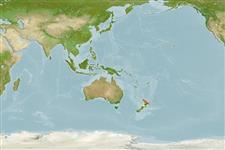分类 / Names
俗名 | 同种异名 | Catalog of Fishes(属, 种) | ITIS | CoL | WoRMS | Cloffa
Teleostei >
Acropomatiformes (Oceanic basses) >
Pempheridae (Sweepers)
Etymology: Pempheris: Greek, pempheris = the name of a fish (Ref. 45335); adspersa: Name from Latin 'sparsus' meaning sprinkled or strewn, referring to the small pigment spots observed on preserved specimens..
Environment: milieu / climate zone / depth range / distribution range
生态学
海洋 礁区鱼类; 深度上下限 0 - 70 m (Ref. 88976). 溫帶
Southwest Pacific: endemic to New Zealand.
西南太平洋: 紐西蘭的特有種。
大小 / 重量 / 年龄
Maturity: Lm ? range ? - ? cm
Max length : 15.8 cm SL 雄鱼/尚未辨别雌雄; (Ref. 88976)
背棘 (总数) : 5 - 6; 背的软条 (总数) : 10 - 12; 臀棘: 3; 臀鳍软条: 29 - 35. This species is distinguished by the following set of characters: some interorbital scales are cycloid; usually 3 or more predorsal scales cycloid, often forming a mesial line of cycloid scales; axillary scale absent; 56-68 lateral-line scales, rarely more than 66; 18-24 scales below lateral line, rarely more than 22; 29-35 anal fin rays; ratio of preanal length to anal-fin base length 1.19-1.55; ratio of pelvic-fin origin to anal-fin origin to anal-fin base length 0.38-0.59; anterior light organ associated with pyloric caeca absent (Ref. 88976).
Nocturnal, retreats to large surge pools or channels open to the sea during the day and usually under overhangs or ledges in small schools. Juveniles occur amongst weed along rocky shores in late summer. Feeds on plankton and benthic organisms (Ref. 26966). Adult diet observed consists of amphipods (45%), mysids (20%), polychaetes (20%), isopods (7%), and crab larvae and ostracods (8%) which are taken out of the water column c. 4-5 m from the bottom. Juveniles that are less than 40 mm are diurnal feeders, mostly feeding on small copepods. Some groups were observed to enter rivers by night in summer and swim well upstream into mangrove forests to feed on crab larvae, shrimps, amphipods, and other zooplankton (Ref. 88976). The smallest identified gravid female was 8.56 cm SL and the largest 12.3 cm SL. Gravid females were found among collections made in mid November into February. These observations agree with reported observations that spawning occurs from November through February and that juveniles settle in January through April (Ref. 88976).
夜行的, 撤退回大的涌浪水池或峡道开放的到海洋在白天期间与通常在被形成小群鱼群的突出部份或岩架下面。 稚鱼出现杂草中在夏末沿着岩岸。 吃浮游生物与底栖的生物。 (参考文献 26966)
Life cycle and mating behavior
Maturities | 繁殖 | Spawnings | Egg(s) | Fecundities | 仔鱼
西南太平洋: 紐西蘭的特有種。
Paulin, C. and C. Roberts, 1992. The rockpool fishes of New Zealand (Te ika aaria o Aotearoa). Museum of New Zealand (Te Papa Tongarewa). 177 p. (Ref. 9003)
人类利用
工具
特别资料
下载 XML
网络资源
Estimates based on models
Preferred temperature (Ref.
123201): 16 - 18.3, mean 17.6 °C (based on 34 cells).
Phylogenetic diversity index (Ref.
82804): PD
50 = 0.5000 [Uniqueness, from 0.5 = low to 2.0 = high].
Bayesian length-weight: a=0.01122 (0.00613 - 0.02054), b=3.02 (2.85 - 3.19), in cm total length, based on LWR estimates for this species & Genus-body shape (Ref.
93245).
营养阶层 (Ref.
69278): 3.0 ±0.0 se; based on diet studies.
Generation time: 2.0 ( na - na) years. Estimated as median ln(3)/K based on 1
growth studies.
回复力 (Ref.
120179): 高度, 族群倍增时间少于 15个月 (K=0.55).
Fishing Vulnerability (Ref.
59153): Low vulnerability (10 of 100).
Nutrients (Ref.
124155): Calcium = 27.7 [11.9, 50.7] mg/100g; Iron = 0.241 [0.131, 0.450] mg/100g; Protein = 18.6 [17.4, 19.9] %; Omega3 = 0.32 [0.17, 0.64] g/100g; Selenium = 6.83 [3.00, 16.03] μg/100g; VitaminA = 49.2 [10.5, 227.2] μg/100g; Zinc = 0.702 [0.435, 1.125] mg/100g (wet weight);
